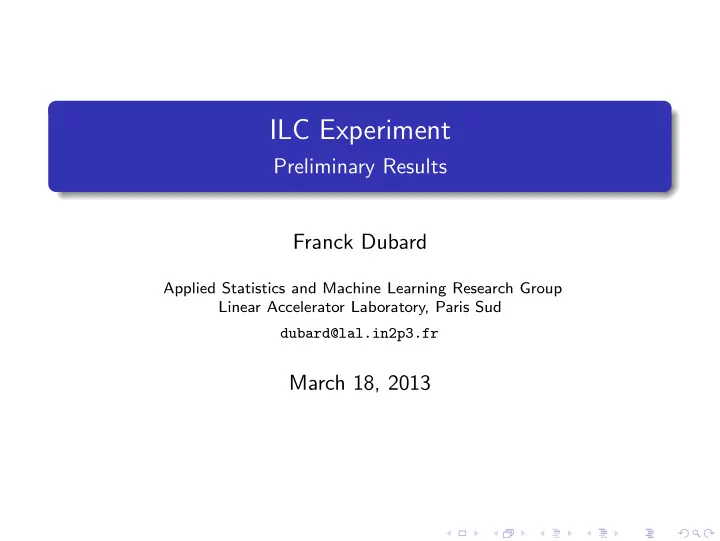

ILC Experiment Preliminary Results Franck Dubard Applied Statistics and Machine Learning Research Group Linear Accelerator Laboratory, Paris Sud dubard@lal.in2p3.fr March 18, 2013
Prerequisite Development Table of Contents Prerequisite 1 Development 2 F. Dubard ILC Experiment
Questions over Deep Learning Prerequisite Family of algorithms Development The DAAs/DAEs Table of Contents Prerequisite 1 Questions over Deep Learning Family of algorithms The Denoising Auto-associators/Auto-encoders Development 2 F. Dubard ILC Experiment
Questions over Deep Learning Prerequisite Family of algorithms Development The DAAs/DAEs Question over Deep Learning F. Dubard ILC Experiment
Questions over Deep Learning Prerequisite Family of algorithms Development The DAAs/DAEs Question over Deep Learning What ? Sub-field of machine learning. F. Dubard ILC Experiment
Questions over Deep Learning Prerequisite Family of algorithms Development The DAAs/DAEs Question over Deep Learning What ? Sub-field of machine learning. When ? Since the 80’s, F. Dubard ILC Experiment
Questions over Deep Learning Prerequisite Family of algorithms Development The DAAs/DAEs Question over Deep Learning What ? Sub-field of machine learning. When ? Since the 80’s, but it is actually only booming until a few years ago. F. Dubard ILC Experiment
Questions over Deep Learning Prerequisite Family of algorithms Development The DAAs/DAEs Question over Deep Learning What ? Sub-field of machine learning. When ? Since the 80’s, but it is actually only booming until a few years ago. Why ? Learning several levels of representations, corresponding to a hierarchy of features or factors or concepts. Most of the algorithms are framed as unsupervised learning. F. Dubard ILC Experiment
Questions over Deep Learning Prerequisite Family of algorithms Development The DAAs/DAEs Family of algorithms 2 different paradigms, but the connections are more tenuous when we consider deeper models 1 1 For more details, please refer to the paper named Representation Learning: A Review and New Perspectives by Y. Bengio, A. Courville and P. Vincent F. Dubard ILC Experiment
Questions over Deep Learning Prerequisite Family of algorithms Development The DAAs/DAEs Family of algorithms 2 different paradigms, but the connections are more tenuous when we consider deeper models 1 Probabilistic Graphical Model Neural Network Model The AAs 1 /AEs 2 variants. RBMs 1 and its derivatives. 1 Restricted Boltzmann Machines 1 Auto-Associators 2 Auto-Encoders 1 For more details, please refer to the paper named Representation Learning: A Review and New Perspectives by Y. Bengio, A. Courville and P. Vincent F. Dubard ILC Experiment
Questions over Deep Learning Prerequisite Family of algorithms Development The DAAs/DAEs Family of algorithms 2 different paradigms, but the connections are more tenuous when we consider deeper models 1 Probabilistic Graphical Model Neural Network Model The AAs 1 /AEs 2 variants. RBMs 1 and its derivatives. 1 Restricted Boltzmann Machines 1 Auto-Associators 2 Auto-Encoders Choice We decided to use AAs/AEs and more precisely, DAAs/DAEs. 1 For more details, please refer to the paper named Representation Learning: A Review and New Perspectives by Y. Bengio, A. Courville and P. Vincent F. Dubard ILC Experiment
Questions over Deep Learning Prerequisite Family of algorithms Development The DAAs/DAEs The DAAs/DAEs Principle y ☛ ✟ ❤ ❤ ❤ PPPPPPPP ✶ ✏ ✏✏✏✏✏✏✏ ✡ ✠ g θ ′ f θ q ☛ ✟ ☛ ✟ ☛ ✟ ✛ q D ✛ ✲ � ❤ ❤ ❤ � ❤ ❤ ❤ ❤ ❤ ❤ ❤ ❤ ❤ ❤ ❤ ❤ ❅ ❅ � ❅ � ❅ ✡ ✠ ✡ ✠ ✡ ✠ L H x ˜ x z Clean input x ∈ [0 , 1] d is partially destroyed, yielding corrupted input: ˜ x ∼ q D ( ˜ x | x ). x is mapped to hidden representation y = f θ ( ˜ x ). ˜ From y , we reconstruct z = g θ ′ ( y ). Train parameters to minimize the cross-entropy ”reconstruction error” L H ( x , z ) = H ( B x ||B z ), where B x denotes multivariate Bernoulli distribution with parameter x . Extracting and Composing Robust Features with Denoising Autoencoders, ICML 2008 F. Dubard ILC Experiment
Toy Problem Prerequisite Real Problem Development Preliminary Results Table of Contents Prerequisite 1 Development 2 Toy Problem Real Problem Preliminary Results F. Dubard ILC Experiment
Toy Problem Prerequisite Real Problem Development Preliminary Results Toy Problem Description We use our method on one of this year ICDAR 1 competitions dataset, the Handwritten Digit and Digit String Recognition Competition 2 . 1 International Conference on Document Analysis and Recognition 2 http://caa.tuwien.ac.at/cvl/research/icdar2013-hdrc F. Dubard ILC Experiment
Toy Problem Prerequisite Real Problem Development Preliminary Results Toy Problem Results The hyperparameters are : Learning Rate : 25% Corruption Level : 90 % Figure : 500 filters of size 28 × 28 F. Dubard ILC Experiment
Toy Problem Prerequisite Real Problem Development Preliminary Results Toy Problem Results The hyperparameters are : Learning Rate : 25% Corruption Level : 90 % Figure : some filters began to show the shape of recognizable number F. Dubard ILC Experiment
Toy Problem Prerequisite Real Problem Development Preliminary Results Real Problem Data Set Characteristics We have 6150 examples. Each one are a vector of 9720 (18 × 18 × 30) numbers. Each number are part of R ≥ 0 , which represents the amount of deposit energy. F. Dubard ILC Experiment
Toy Problem Prerequisite Real Problem Development Preliminary Results Preliminary Results Simulation... F. Dubard ILC Experiment
Recommend
More recommend